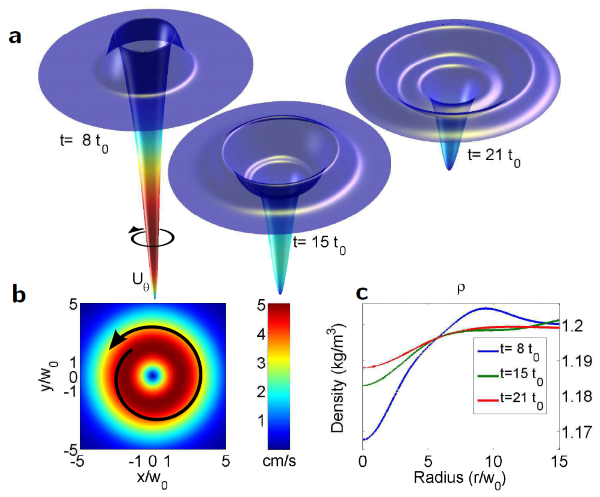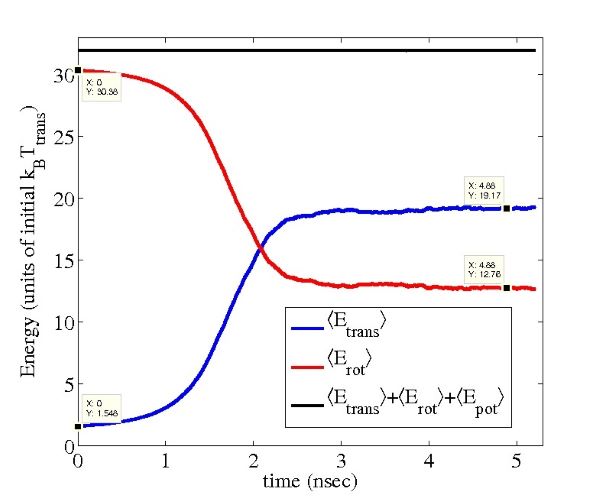The possibility of creating molecules excited to extremely high rotational states (super rotors) enables us to explore new kinetic effects in molecular gases.
One effect that we predict is the creation of a macroscopic vortex that develops in a gas of molecules rotationally excited by a laser [1]. There are several ways to use lasers in order to excite molecular unidirectional rotation (when the molecules rotate on average in one sense). We use the basic physical principle of angular momentum conservation to analyze the situation after collisions have wiped out any "memory" of the rotation of an individual particle, and thermal equilibrium is reached. We argue that instead of the individual spin, a macroscopic whirlpool emerges, with a typical size of the laser beam diameter. The gas vortex motion now carries the non-zero angular momentum of the system. Our numerical analysis validates the prediction, as seen in Fig. 1:

Fig. 1: Density (height) and tangential velocity (color) distributions at different times
It is also interesting to investigate the relaxation process of the rotationally excited molecules. The system of rapidly spinning molecules is out of equilibrium. Although initially, the translational motion of molecules corresponds to the ambient conditions, the rotational velocity of the laser-excited molecules may correspond to a temperature of tens of thousands of Kelvins (10,000 K)! After a long enough period of time (several nanoseconds for oxygen molecules, see Fig. 2), all the degrees of freedom return to thermal equilibrium, such that the ratio between the average translational (<Etrans>) and the average rotational energy (<Erot>) is equal to 3/2 for linear molecules. The interesting question is what happens in between. The naïve assumption is that the average rotational energy of the molecules will decay exponentially until reaching its new equilibrium value. However, molecular dynamics simulations predict a highly non-exponential, explosive behavior:

Fig. 2: Time dependence of the energy of molecules that were given initially a high rotational velocity (such that <Erot>/<Etrans> is equal to 20).
Here is a movie illustrating the explosive relaxation of oxygen super rotors
- U. Steinitz, Y. Prior, and I. Sh. Averbukh, “Laser-Induced Gas Vortices”,
Phys. Rev. Lett. 109, 033001 (2012) - Y. Khodorkovsky, U. Steinitz, J.-M. Hartmann, and I. Sh. Averbukh, “Collisional dynamics in a gas of molecular super-rotors”, Nat. Commun. 6, 7791 (2015)
- U. Steinitz, Y. Khodorkovsky, J.-M. Hartmann, and I. Sh. Averbukh, “Dynamics and Hydrodynamics of Molecular Superrotors”, ChemPhysChem. 17, 22, 3795 (2016)


